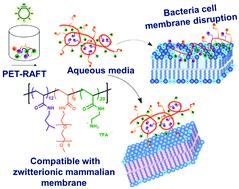当前位置:
X-MOL 学术
›
Polym. Chem.
›
论文详情
Our official English website, www.x-mol.net, welcomes your
feedback! (Note: you will need to create a separate account there.)
Effect of hydrophilic groups on the bioactivity of antimicrobial polymers
Polymer Chemistry ( IF 4.1 ) Pub Date : 2021-09-16 , DOI: 10.1039/d1py01075a Phuong Pham 1 , Susan Oliver 1 , Edgar H. H. Wong 1 , Cyrille Boyer 1
Polymer Chemistry ( IF 4.1 ) Pub Date : 2021-09-16 , DOI: 10.1039/d1py01075a Phuong Pham 1 , Susan Oliver 1 , Edgar H. H. Wong 1 , Cyrille Boyer 1
Affiliation

|
Antimicrobial polymers have recently been investigated as potential treatments to combat multidrug-resistant pathogens. A typical antimicrobial polymer consists of cationic groups that allow the polymers to adsorb onto negatively charged bacterial membranes and hydrophobic groups that insert into and disrupt the bilipid membrane. Recently, with the introduction of ternary polymer systems, neutral hydrophilic groups have been added to modulate hydrophobic/hydrophilic balance more easily. Although numerous studies have examined the effect of active components (cationic and hydrophobic groups) of antimicrobial polymers on their bioactivity, limited studies focus on hydrophilic groups. Therefore, in this study, we developed a series of statistical amphiphilic ternary polymers to systematically investigate the effect of hydrophilic groups on antibacterial activity and biocompatibility. The results revealed that, unlike the hydrophobic groups that directly disrupt the cell membrane, the hydrophilic groups have an indirect but important impact on bioactivity through tuning of the hydrophobic/hydrophilic balance and global hydrophobicity, leading to a change in the aqueous characteristics of the polymers. Therefore, in antimicrobial polymer design, an appropriate hydrophobic/hydrophilic balance as well as the structural features of the hydrophilic group, such as length, flexibility, and hydrophilicity of the hydrophilic chain, are key determinants that can be optimised to maximise biocompatibility without negatively impacting antibacterial effect.
中文翻译:

亲水基团对抗菌聚合物生物活性的影响
抗微生物聚合物最近被研究作为对抗多重耐药病原体的潜在治疗方法。典型的抗微生物聚合物由阳离子基团组成,这些阳离子基团使聚合物能够吸附到带负电荷的细菌膜上,以及插入并破坏双脂膜的疏水基团。最近,随着三元聚合物系统的引入,添加了中性亲水基团以更容易地调节疏水/亲水平衡。尽管许多研究已经检查了抗菌聚合物的活性成分(阳离子和疏水基团)对其生物活性的影响,但有限的研究集中在亲水基团上。因此,在本研究中,我们开发了一系列统计两亲性三元聚合物,以系统地研究亲水基团对抗菌活性和生物相容性的影响。结果表明,与直接破坏细胞膜的疏水基团不同,亲水基团通过调节疏水/亲水平衡和整体疏水性对生物活性产生间接但重要的影响,导致聚合物的水性特性发生变化。 . 因此,在抗菌聚合物设计中,适当的疏水/亲水平衡以及亲水基团的结构特征,如亲水链的长度、柔韧性和亲水性,是关键的决定因素,可以对其进行优化以最大限度地提高生物相容性,而不会产生负面影响。抗菌作用。
更新日期:2021-09-24
中文翻译:

亲水基团对抗菌聚合物生物活性的影响
抗微生物聚合物最近被研究作为对抗多重耐药病原体的潜在治疗方法。典型的抗微生物聚合物由阳离子基团组成,这些阳离子基团使聚合物能够吸附到带负电荷的细菌膜上,以及插入并破坏双脂膜的疏水基团。最近,随着三元聚合物系统的引入,添加了中性亲水基团以更容易地调节疏水/亲水平衡。尽管许多研究已经检查了抗菌聚合物的活性成分(阳离子和疏水基团)对其生物活性的影响,但有限的研究集中在亲水基团上。因此,在本研究中,我们开发了一系列统计两亲性三元聚合物,以系统地研究亲水基团对抗菌活性和生物相容性的影响。结果表明,与直接破坏细胞膜的疏水基团不同,亲水基团通过调节疏水/亲水平衡和整体疏水性对生物活性产生间接但重要的影响,导致聚合物的水性特性发生变化。 . 因此,在抗菌聚合物设计中,适当的疏水/亲水平衡以及亲水基团的结构特征,如亲水链的长度、柔韧性和亲水性,是关键的决定因素,可以对其进行优化以最大限度地提高生物相容性,而不会产生负面影响。抗菌作用。











































 京公网安备 11010802027423号
京公网安备 11010802027423号